Analysis of COVID-19 Lockdown to Understand Air Pollution Processes and Their Impacts on Health: A Case Study in the Western Balkans
Abstract
1. Introduction
2. Materials and Methods
3. Results
3.1. Variations in 2020 Compared with the Time Series
3.2. Comparison with Traffic Counts
3.3. Analysis of Meteorological Variables
3.4. Impacts on Health
4. Discussion
5. Conclusions
Supplementary Materials
Author Contributions
Funding
Institutional Review Board Statement
Informed Consent Statement
Data Availability Statement
Conflicts of Interest
References
- Vardari, L. The effects of COVID-19 pandemic on Western Balkan financial markets. In Data Science for COVID-19; Kose, U., Gupta, D., Hugo, C.V.d.A., Khanna, A., Eds.; Academic Press: Cambridge, MA, USA, 2022; pp. 449–464. [Google Scholar] [CrossRef]
- Nicolini, G.; Antoniella, G.; Carotenuto, F.; Christen, A.; Ciais, P.; Feigenwinter, C.; Gioli, B.; Stagakis, S.; Velasco, E.; Vogt, R.; et al. Direct observations of CO2 emission reductions due to COVID-19 lockdown across European urban districts. Sci. Total Environ. 2022, 830, 154662. [Google Scholar] [CrossRef] [PubMed]
- Zambrano-Monserrate, M.A.; Ruano, M.A.; Sanchez-Alcalde, L. Indirect Effects of COVID-19 on the Environment. Sci. Total Environ. 2020, 728, 138813. [Google Scholar] [CrossRef] [PubMed]
- Kumar, S. Insights on Air Pollution During COVID-19: A Review. Aerosol Sci. Eng. 2023, 7, 192–206. [Google Scholar] [CrossRef]
- Roh, T.; Moreno-Rangel, A.; Baek, J.; Obeng, A.; Hasan, N.T.; Carrillo, G. Indoor Air Quality and Health Outcomes in Employees Working from Home during the COVID-19 Pandemic: A Pilot Study. Atmosphere 2021, 12, 1665. [Google Scholar] [CrossRef]
- Gkatzelis, G.I.; Gilman, J.B.; Brown, S.S.; Eskes, H.; Gomes, A.R.; Lange, A.C.; McDonald, B.C.; Peischl, J.; Petzold, A.; Thompson, C.R.; et al. The global impacts of COVID-19 lockdowns on urban air pollution. Elementa Sci. Anthr. 2021, 9, 00176. [Google Scholar] [CrossRef]
- Rahman, M.; Meng, L. Examining the Spatial and Temporal Variation of PM2.5 and Its Linkage with Meteorological Conditions in Dhaka, Bangladesh. Atmosphere 2024, 15, 1426. [Google Scholar] [CrossRef]
- Holland, R.; Seifert, K.; Saboya, E.; Khan, M.A.H.; Derwent, R.G.; Shallcross, D.E. Elucidating the Effects of COVID-19 Lockdowns in the UK on the O3-NOx-VOC Relationship. Atmosphere 2024, 15, 607. [Google Scholar] [CrossRef]
- Nakada, L.Y.K.; Urban, R.C. COVID-19 pandemic: Impacts on the air quality during the partial lockdown in São Paulo state, Brazil. Sci. Total Environ. 2020, 730, 139087. [Google Scholar] [CrossRef]
- Li, L.; Li, Q.; Huang, L.; Wang, Q.; Zhu, A.; Xu, J.; Liu, Z.; Li, H.; Shi, L.; Li, R.; et al. Air quality changes during the COVID-19 lockdown over the Yangtze River Delta Region: An insight into the impact of human activity pattern changes on air pollution variation. Sci. Total Environ. 2020, 732, 139282. [Google Scholar] [CrossRef]
- Giardi, F.; Nava, S.; Calzolai, G.; Pazzi, G.; Chiari, M.; Faggi, A.; Andreini, B.P.; Collaveri, C.; Franchi, E.; Nincheri, G.; et al. PM 10 variation, composition, and source analysis in Tuscany (Italy) following the COVID-19 lockdown restrictions. Atmos. Chem. Phys. 2022, 22, 9987–10005. [Google Scholar] [CrossRef]
- Petit, J.-E.; Dupont, J.-C.; Favez, O.; Gros, V.; Zhang, Y.; Sciare, J.; Simon, L.; Truong, F.; Bonnaire, N.; Amodeo, T.; et al. Response of atmospheric composition to COVID-19 lockdown measures during Spring in the Paris region (France). Atmos. Chem. Phys. 2021, 21, 17167–17183. [Google Scholar] [CrossRef]
- Soares, A.R.; Silva, C.M. What Can the COVID-19 Pandemic Tell Us About the Energy Transition? A Nitrogen Dioxide and Ground-Level Ozone Study. Atmosphere 2024, 15, 1453. [Google Scholar] [CrossRef]
- Samad, A.; Arango, K.; Chourdakis, I.; Vogt, U. Contribution of Airplane Engine Emissions on the Local Air Quality around Stuttgart Airport during and after COVID-19 Lockdown Measures. Atmosphere 2022, 13, 2062. [Google Scholar] [CrossRef]
- Eleftheriadis, K.; Gini, M.I.; Diapouli, E.; Vratolis, S.; Vasilatou, V.; Fetfatzis, P.; Manousakas, M.I. Aerosol microphysics and chemistry reveal the COVID19 lockdown impact on urban air quality. Sci. Rep. 2021, 11, 14477. [Google Scholar] [CrossRef]
- Evangeliou, N.; Platt, S.M.; Eckhardt, S.; Myhre, C.L.; Laj, P.; Alados-Arboledas, L.; Backman, J.; Brem, B.T.; Fiebig, M.; Flentje, H.; et al. Changes in black carbon emissions over Europe due to COVID-19 lockdowns. Atmos. Chem. Phys. 2021, 21, 2675–2692. [Google Scholar] [CrossRef]
- Belis, C.; DJatkov, D.; Dobricic, S.; De Meij, A.; Kolarević, S.; Arias Navarro, C.; Wojda, P.; Jones, A.; Lamy, M.-C.; Porcel Rodriguez, E.; et al. Status of Environment and Climate in the Western Balkans; Publications Office of the European Union: Luxembourg, 2024; Available online: https://data.europa.eu/doi/10.2760/1865356 (accessed on 19 December 2024).
- EMEP Centre on Emission Inventories and Projections. WebDab Reported Emission Data. Available online: https://www.ceip.at/webdab-emission-database/reported-emissiondata (accessed on 19 December 2024).
- EEA, European Environmental Agency. Europe’s Air Quality Status 2024. Available online: https://www.eea.europa.eu/publications/europes-air-quality-status-2024 (accessed on 19 December 2024).
- Belis, C.A.; Pisoni, E.; Degraeuwe, B.; Peduzzi, E.; Thunis, P.; Monforti-Ferrario, F.; Guizzardi, D. Urban pollution in the Danube and Western Balkans regions: The impact of major PM2.5 sources. Environ. Int. 2019, 133, 105158. [Google Scholar] [CrossRef]
- Kusugak, M.; Miljevic, D.; Rajakovic, N. Chaotic and Fake Decarbonization of Power Sectors in the Western Balkans (Evaluation of International Policies). Center for Sustainable Energy Transition (RESET). 2023. Available online: https://reset.ba/images/2023/11_novembar/Chaotic%20and%20fake%20decarbonization%20on%20WB%20RESET%20web.pdf (accessed on 19 December 2024).
- Denby, B.R.; Klimont, Z.; Nyiri, A.; Kiesewetter, G.; Heyes, C.; Fagerli, H. Future scenarios for air quality in Europe, the Western Balkans and EECCA countries: An assessment for the Gothenburg protocol review. Atmos. Environ. 2024, 333, 120602. [Google Scholar] [CrossRef]
- Nesterovic, A.; Djatkov, D.; Viskovic, M.; Martinov, M.; Adamovic, D. Air pollutants emissions from biomass combustion in the City of Novi Sad, Serbia. Biomass Convers. Biorefinery 2021, 13, 10935–10946. [Google Scholar] [CrossRef]
- Banja, M.; Đukanović, G.; Belis, C.A. Status of Air Pollutants and Greenhouse Gases in the Western Balkans: Benchmarking the Accession Process Progress on Environment; EUR 30113 EN; Publications Office of the European Union: Luxembourg, 2020; ISBN 978-92-76-16860-7. [Google Scholar] [CrossRef]
- European Commission: Joint Research Centre; Belis, C.; Djatkov, D.; Lettieri, T.; Jones, A.; Wojda, P.; Banja, M.; Muntean, M.; Paunović, M.; Niegowska, M.; et al. Status of Environment and Climate in the Western Balkans—Benchmarking the Accession Process Progress on Environment; Publications Office of the European Union: Luxembourg, 2022; Available online: https://data.europa.eu/doi/10.2760/294516 (accessed on 19 December 2024).
- European Environmental Agency (EEA). Premature Deaths Due to Exposure to Fine Particulate Matter PM2.5 (2005-2021), EU SDG 11_52. Available online: https://sdi.eea.europa.eu/catalogue/srv/eng/catalog.search#/metadata/9159207e-7ef2-4c93-b531-f73a213f3e17 (accessed on 19 December 2024).
- Ma, Y.; Nobile, F.; Marb, A.; Dubrow, R.; Kinney, P.L.; Peters, A.; Stafoggia, M.; Breitner, S.; Chen, K. Air pollution changes due to COVID-19 lockdowns and attributable mortality changes in four countries. Environ. Int. 2024, 187, 108668. [Google Scholar] [CrossRef]
- Son, J.-Y.; Fong, K.C.; Heo, S.; Kim, H.; Lim, C.C.; Bell, M.L. Reductions in mortality resulting from reduced air pollution levels due to COVID-19 mitigation measures. Sci. Total Environ. 2020, 744, 141012. [Google Scholar] [CrossRef]
- Murray, C.J.; Ezzati, M.; Lopez, A.D.; Rodgers, A.; Vander Hoorn, S. Comparative quantification of health risks: Conceptual framework and methodological issues. Popul. Health Metr. 2003, 1, 1. [Google Scholar] [CrossRef] [PubMed]
- Huangfu, P.; Atkinson, R. Long-term exposure to NO2 and O3 and all-cause and respiratory mortality: A systematic review and meta-analysis. Environ. Int. 2020, 144, 105998. [Google Scholar] [CrossRef] [PubMed]
- Chen, J.; Hoek, G. Long-term exposure to PM and all-cause and cause-specific mortality: A systematic review and meta-analysis. Environ. Int. 2020, 143, 105974. [Google Scholar] [CrossRef] [PubMed]
- Melchiorri, M.; Mari Rivero, I.; Florio, P.; Schiavina, M.; Krasnodebska, K.; Politis, P.; Uhl, J.; Pesaresi, M.; Maffenini, L.; Sulis, P.; et al. Stats in the City—The GHSL Urban Centre Database 2025—Public Release GHS-UCDB R2024 ed; Publications Office of the European Union: Luxembourg, 2024. [Google Scholar]
- WHO. 2024. Available online: https://www.who.int/data/data-collection-tools/who-mortality-database (accessed on 19 December 2024).
- Belis, C.A.; Matkovic, V.; Ballocci, M.; Jevtic, M.; Millo, G.; Mata, E.; Van Dingenen, R. Assessment of health impacts and costs attributable to air pollution in urban areas using two different approaches. A case study in the Western Balkans. Environ. Int. 2023, 182, 108347. [Google Scholar] [CrossRef]
- Crippa et al. Global Air Pollutants Emissions EDGAR V 8.1. 2024. Available online: https://edgar.jrc.ec.europa.eu/dataset_ap81 (accessed on 19 December 2024).
- Grange, S.K.; Lee, J.D.; Drysdale, W.S.; Lewis, A.C.; Hueglin, C.; Emmenegger, L.; Carslaw, D.C. COVID-19 lockdowns highlight a risk of increasing ozone pollution in European urban areas. Atmos. Chem. Phys. 2021, 21, 4169–4185. [Google Scholar] [CrossRef]
- INERIS (Institut National de l’Environnement Industriel et des Risques). The Lockdown and Air Quality: Nitrogen Dioxide Pollution Falls in France’s Largest Cities. Available online: https://www.ineris.fr/en/ineris/news/lockdown-and-air-quality-nitrogen-dioxide-pollution-falls-france-largest-cities (accessed on 26 July 2024).
- Stringency Index. Our World in Data. 2022. Available online: https://ourworldindata.org/grapher/covid-stringency-index (accessed on 19 December 2024).
- Putaud, J.-P.; Pozzoli, L.; Pisoni, E.; Dos Santos, S.M.; Lagler, F.; Lanzani, G.; Santo, U.D.; Colette, A. Impacts of the COVID-19 lockdown on air pollution at regional and urban background sites in northern Italy. Atmos. Chem. Phys. 2021, 21, 7597–7609. [Google Scholar] [CrossRef]
- Shen, H.; Luo, Z.; Xiong, R.; Liu, X.; Zhang, L.; Li, Y.; Du, W.; Chen, Y.; Cheng, H.; Shen, G.; et al. A critical review of pollutant emission factors from fuel combustion in home stoves. Environ. Int. 2021, 157, 106841. [Google Scholar] [CrossRef]
- Almeida, S.; Manousakas, M.; Diapouli, E.; Kertesz, Z.; Samek, L.; Hristova, E.; Šega, K.; Alvarez, R.P.; Belis, C.; Eleftheriadis, K. Ambient particulate matter source apportionment using receptor modelling in European and Central Asia urban areas. Environ. Pollut. 2020, 266, 115199. [Google Scholar] [CrossRef]
- Bao, R.; Zhang, A. Does lockdown reduce air pollution? Evidence from 44 cities in northern China. Sci. Total Environ. 2020, 731, 139052. [Google Scholar] [CrossRef]
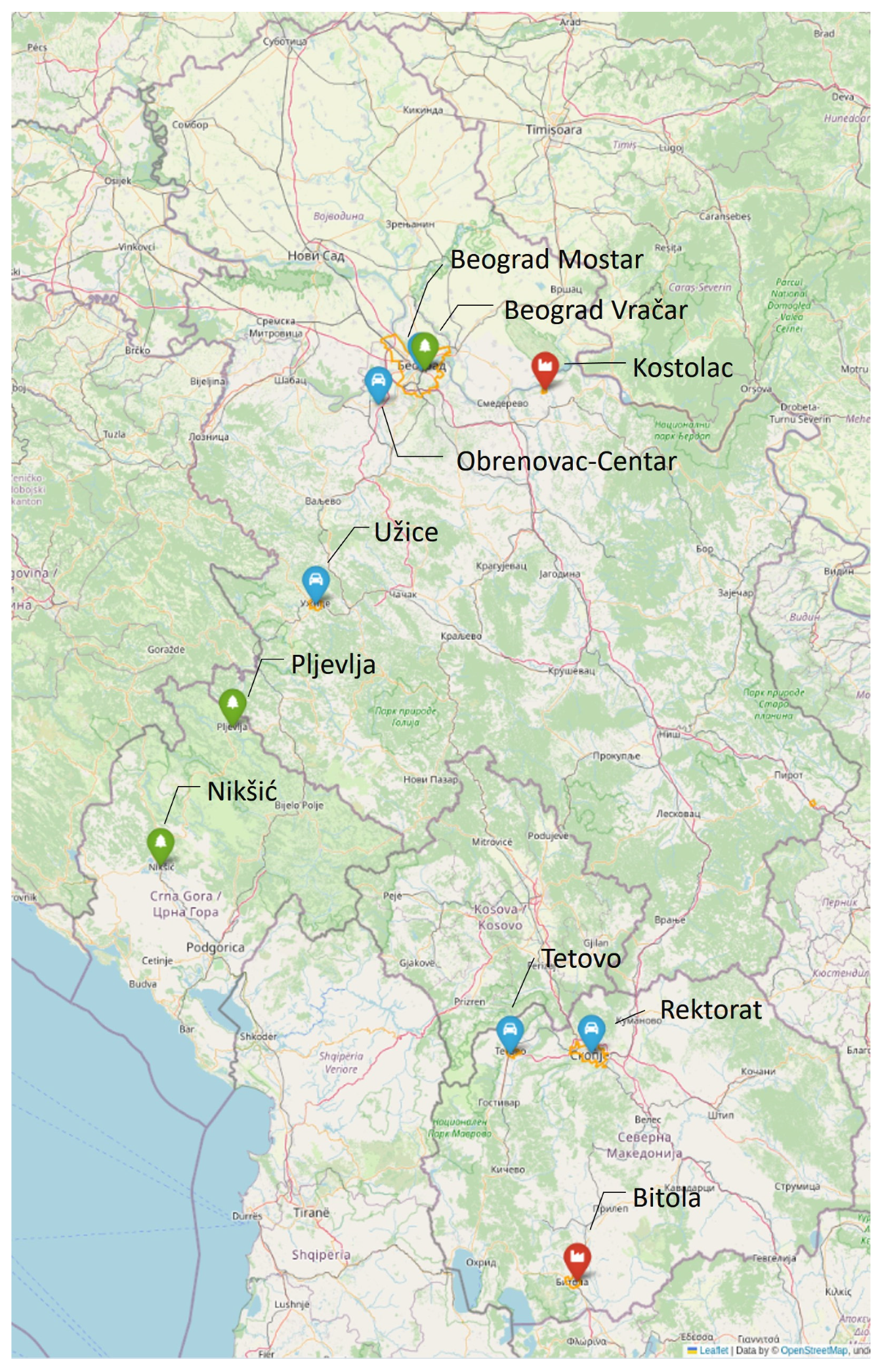
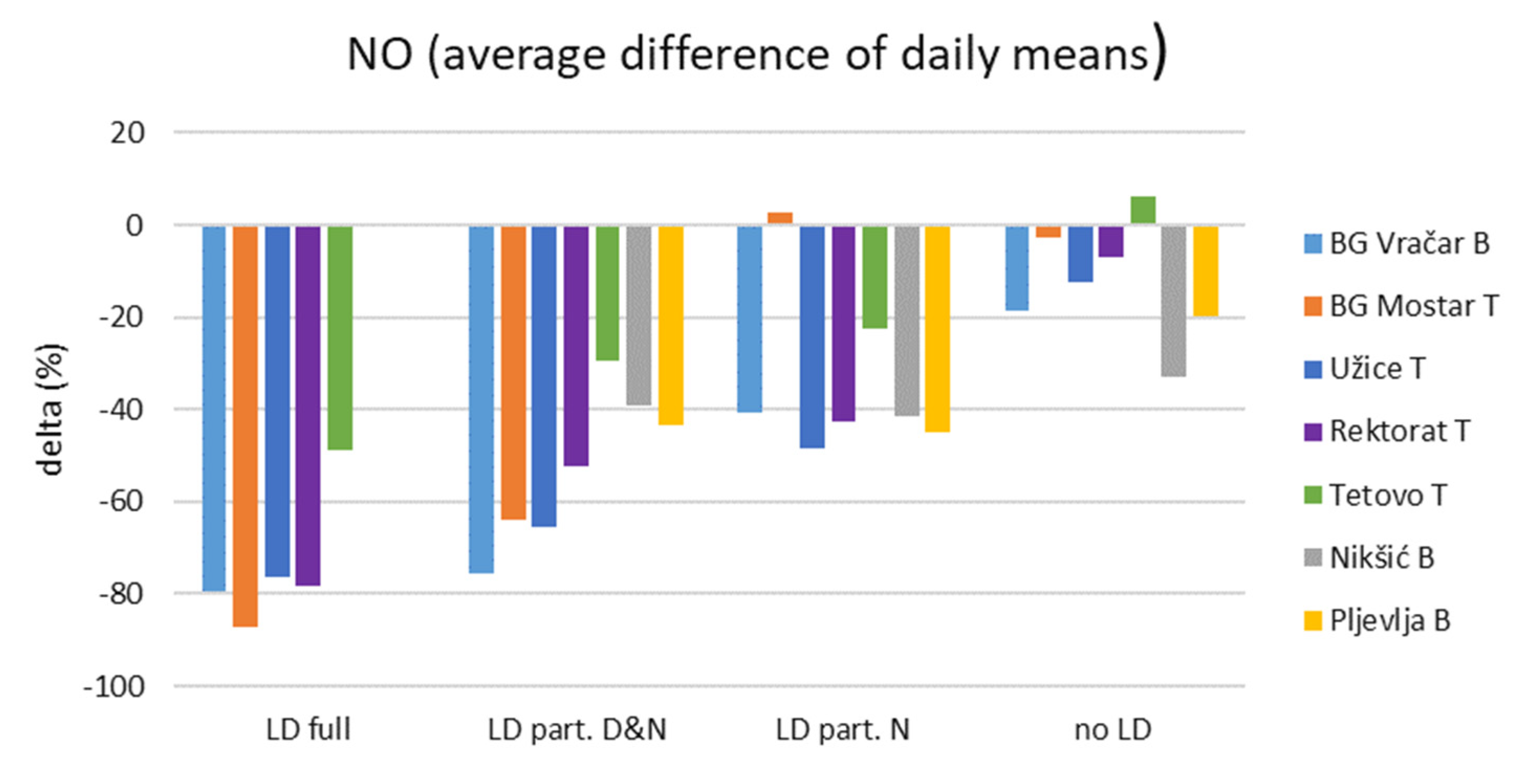
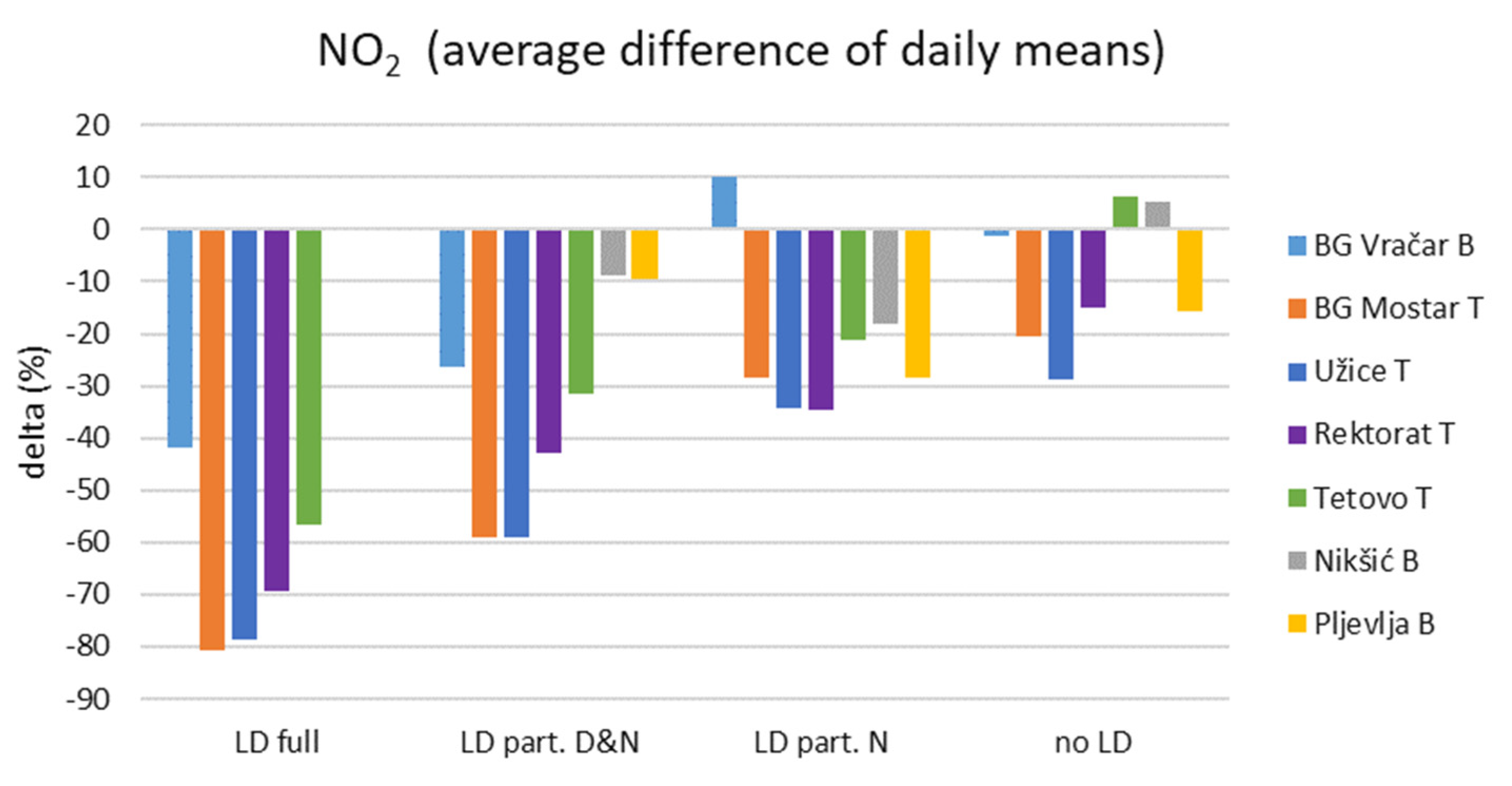
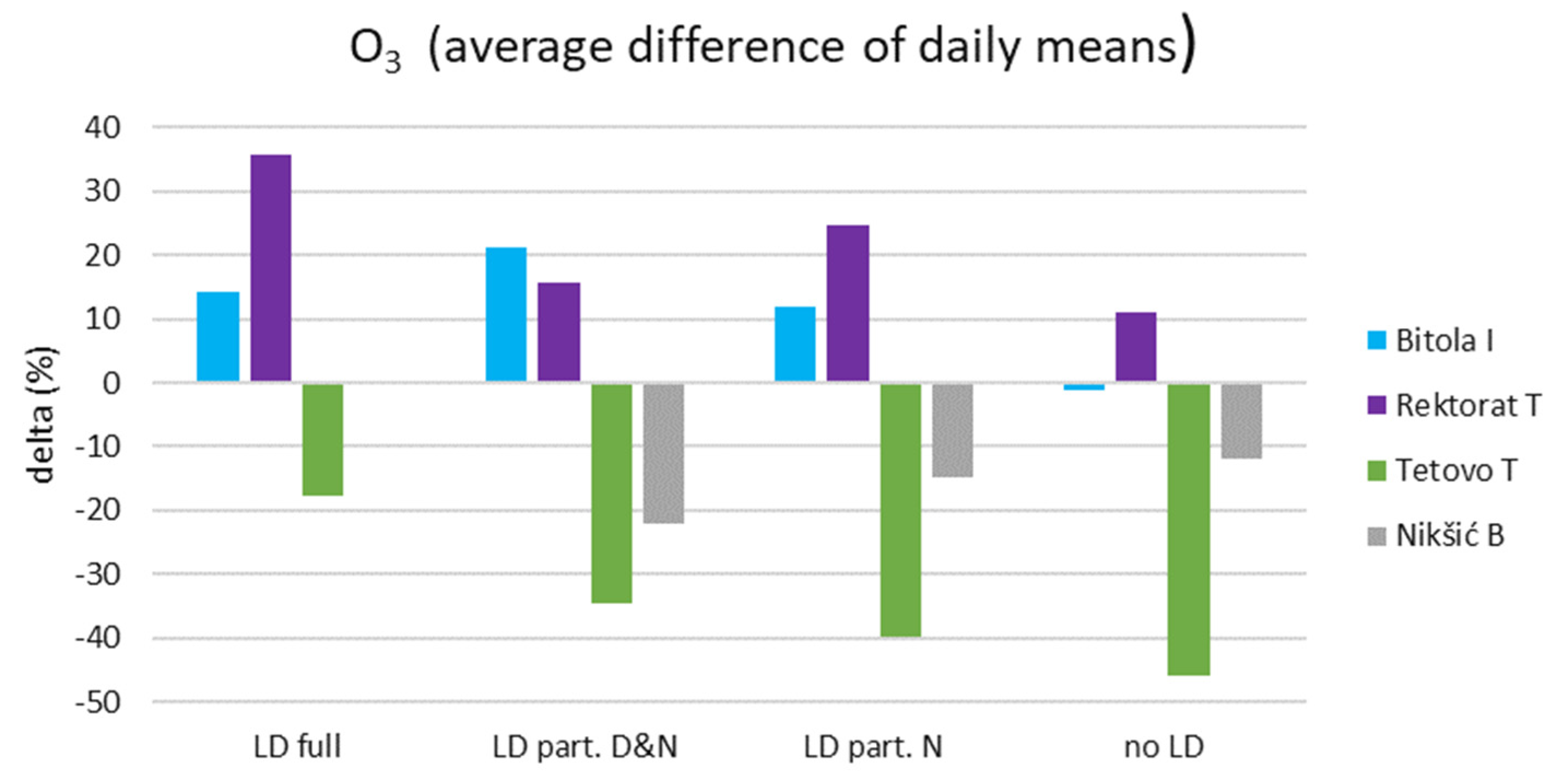


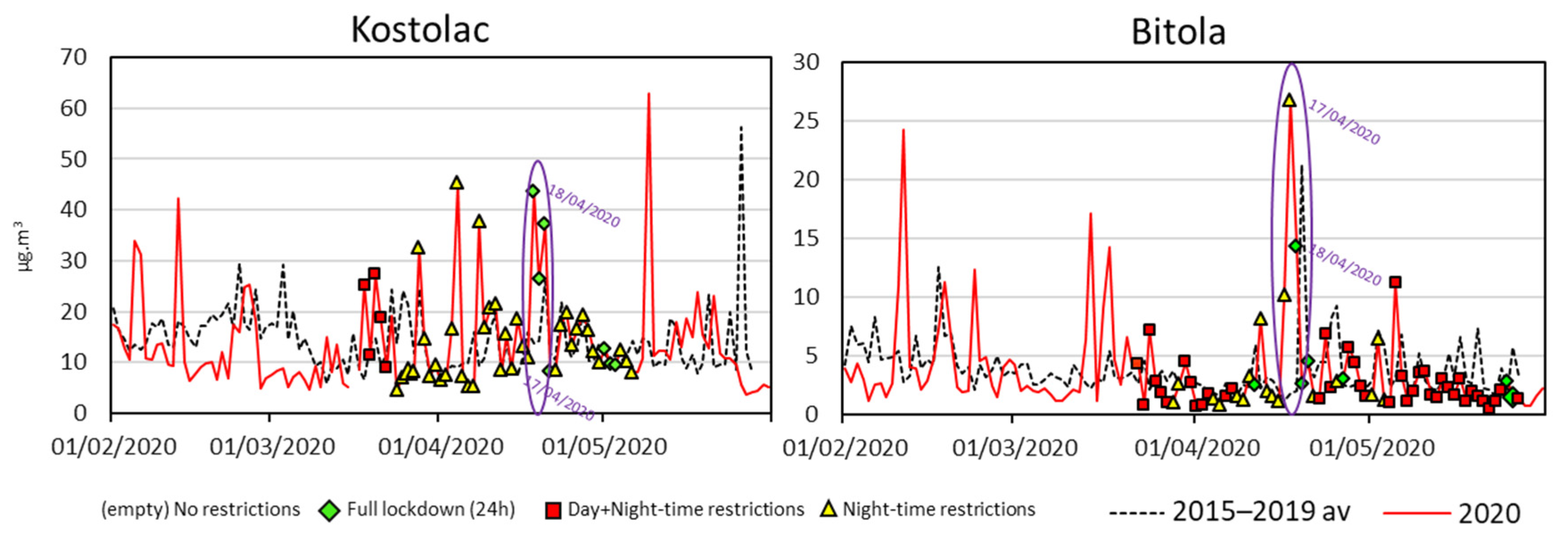
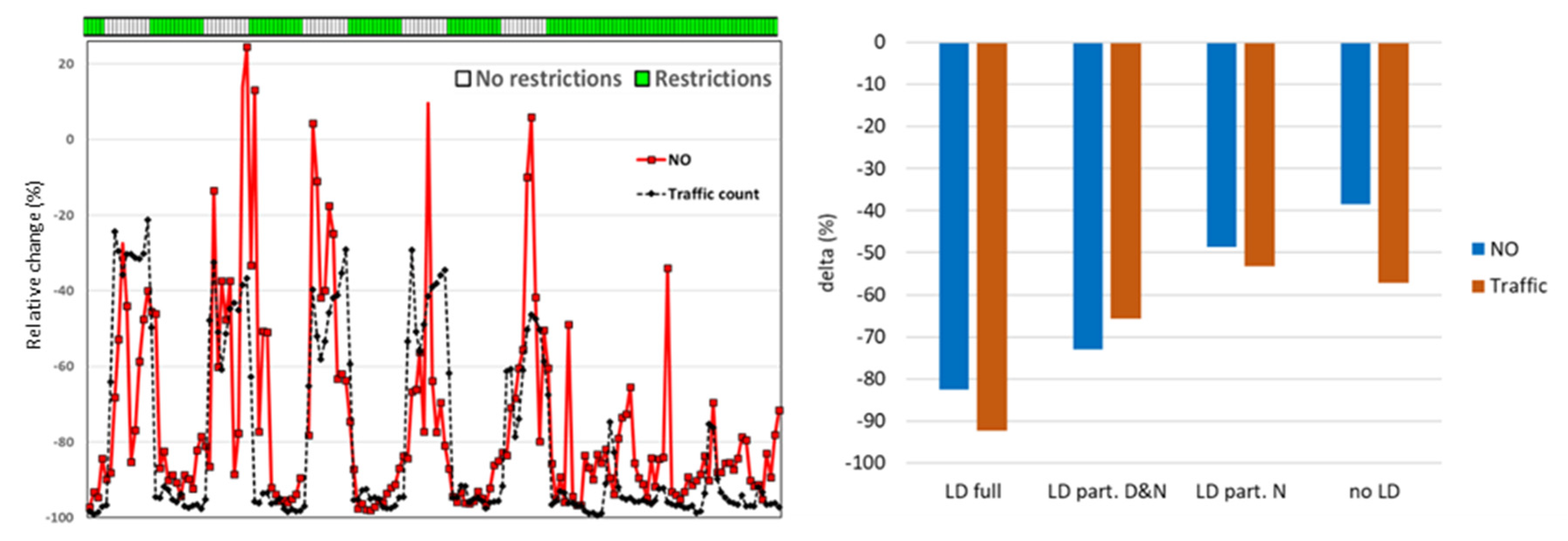

| 2015–2019 Average | 2020 | 2020 vs. 2015–2019 Average | ||
|---|---|---|---|---|
| Sector | Contribution, % | Sector | Contribution, % | Relative Change, % |
| PM2.5 | ||||
| Overall | 100.0 | Overall | 100.0 | 3.7 |
| Public power | 8.7 | Public power | 6.2 | −26.2 |
| Residential | 67.9 | Residential | 74.0 | 12.9 |
| Road transport | 5.3 | Road transport | 5.3 | 4.8 |
| NOx | ||||
| Overall | 100.0 | Overall | 100.0 | −5.1 |
| Public power | 38.2 | Public power | 35.9 | −10.7 |
| Residential | 5.4 | Residential | 5.9 | 4.1 |
| Road transport | 28.0 | Road transport | 30.8 | 4.5 |
| SOx | ||||
| Overall | 100.0 | Overall | 100.0 | 16.4 |
| Public power | 90.5 | Public power | 92.4 | 18.9 |
| Residential | 2.4 | Residential | 1.9 | −8.9 |
| Road transport | 0.4 | Road transport | 0.5 | 35.9 |
| EoI Code | Name | Country ISO 3 * | Type | Area | Longitude | Latitude |
|---|---|---|---|---|---|---|
| MK0043A | Rektorat | MKD | Traffic | Urban | 21.4408 | 41.9992 |
| MK0041A | Tetovo | MKD | Traffic | Urban | 20.9652 | 41.9976 |
| MK0037A | Bitola 1 UHMR | MKD | Industrial | Urban | 21.3564 | 41.04 |
| RS0028A | Belgrade–Mostar | SRB | Traffic | Urban | 20.4502 | 44.7987 |
| RS0037A | Belgrade–Vračar | SRB | Background | Urban | 20.4753 | 44.797 |
| RS0051A | Obrenovac–Centar | SRB | Traffic | Urban | 20.2045 | 44.6595 |
| RS0054A | Užice | SRB | Traffic | Urban | 19.8432 | 43.8543 |
| RS0038A | Kostolac | SRB | Industrial | Suburban | 21.1734 | 44.7175 |
| ME0009A | Nikšić2 | MNE | Background | Urban | 18.9400 | 42.7800 |
| ME0001A | Pljevlja | MNE | Background | Urban | 19.3581 | 43.355 |
| Station | Short Name | Time Series | PM10 | PM2.5 | NO | NO2 | O3 | SO2 | METEO |
|---|---|---|---|---|---|---|---|---|---|
| Rektorat | Rektorat | 2015–2020 | x | x | x | x | x | ||
| Tetovo | Tetovo | 2015–2020 | x | x | x | x | x | x | |
| Bitola 1 | Bitola | 2015–2020 | x | x | x | ||||
| Beograd–Mostar | BG Mostar | 2017–2020 | x | x | x | x | x | ||
| Beograd–Vračar | BG Vračar | 2017–2020 | x | x | x | x | x | ||
| Obrenovac–Centar | Obrenovac | 2017–2020 | x | x | x | ||||
| Užice | Užice | 2017–2020 | x | x | x | x | x | ||
| Kostolac | Kostolac | 2017–2020 | x | ||||||
| Nikšić | Nikšić | 2015–2020 | x | x | x | x | x | x | |
| Pljevlja | Pljevlja | 2015–2020 | x | x | x | x | x | x |
| Pollutant | Site | Prevented Mortality in the Studied Period | Prevented Mortality on Yearly Basis | Relative Change | |||
|---|---|---|---|---|---|---|---|
| February–May | No Restriction | February–May | No Restriction | February–May | No Restriction | ||
| NO2 | Belgrade Vračar | −38 | −3 | −113 | −15 | −15% | −2% |
| NO2 | Nikšić | 0 | 0 | −1 | 1 | −24% | 15% |
| NO2 | Pljevlja | −1 | −1 | −4 | −10 | −22% | −41% |
| O3 | Nikšić | −2 | −1 | −6 | −4 | −16% | −12% |
| PM2.5 | Nikšić | 6 | 3 | 19 | 23 | 24% | 22% |
| PM2.5 | Pljevlja | −3 | −1 | −10 | −11 | −23% | −16% |
Disclaimer/Publisher’s Note: The statements, opinions and data contained in all publications are solely those of the individual author(s) and contributor(s) and not of MDPI and/or the editor(s). MDPI and/or the editor(s) disclaim responsibility for any injury to people or property resulting from any ideas, methods, instructions or products referred to in the content. |
© 2025 by the authors. Licensee MDPI, Basel, Switzerland. This article is an open access article distributed under the terms and conditions of the Creative Commons Attribution (CC BY) license (https://creativecommons.org/licenses/by/4.0/).
Share and Cite
Belis, C.A.; Djatkov, D.; Toceva, M.; Knezevic, J.; Djukanovic, G.; Stefanovska, A.; Golubov, N.; Jovic, B.; Gavros, A. Analysis of COVID-19 Lockdown to Understand Air Pollution Processes and Their Impacts on Health: A Case Study in the Western Balkans. Atmosphere 2025, 16, 90. https://doi.org/10.3390/atmos16010090
Belis CA, Djatkov D, Toceva M, Knezevic J, Djukanovic G, Stefanovska A, Golubov N, Jovic B, Gavros A. Analysis of COVID-19 Lockdown to Understand Air Pollution Processes and Their Impacts on Health: A Case Study in the Western Balkans. Atmosphere. 2025; 16(1):90. https://doi.org/10.3390/atmos16010090
Chicago/Turabian StyleBelis, Claudio A., Djordje Djatkov, Martina Toceva, Jasmina Knezevic, Gordana Djukanovic, Aneta Stefanovska, Nikola Golubov, Biljana Jovic, and Andreas Gavros. 2025. "Analysis of COVID-19 Lockdown to Understand Air Pollution Processes and Their Impacts on Health: A Case Study in the Western Balkans" Atmosphere 16, no. 1: 90. https://doi.org/10.3390/atmos16010090
APA StyleBelis, C. A., Djatkov, D., Toceva, M., Knezevic, J., Djukanovic, G., Stefanovska, A., Golubov, N., Jovic, B., & Gavros, A. (2025). Analysis of COVID-19 Lockdown to Understand Air Pollution Processes and Their Impacts on Health: A Case Study in the Western Balkans. Atmosphere, 16(1), 90. https://doi.org/10.3390/atmos16010090







